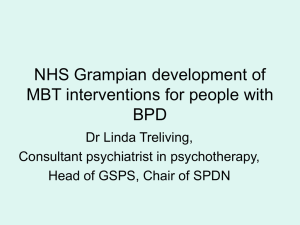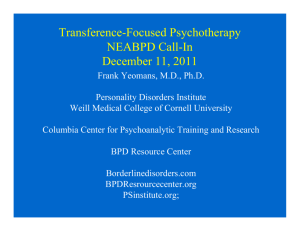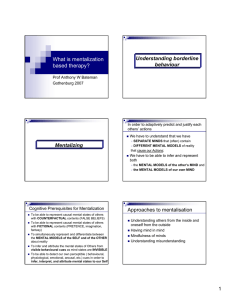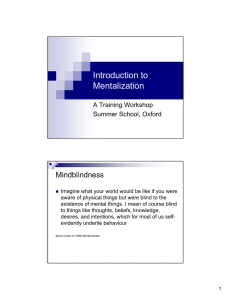Complexities in Narcissistic Personality Disorder Assessment
advertisement
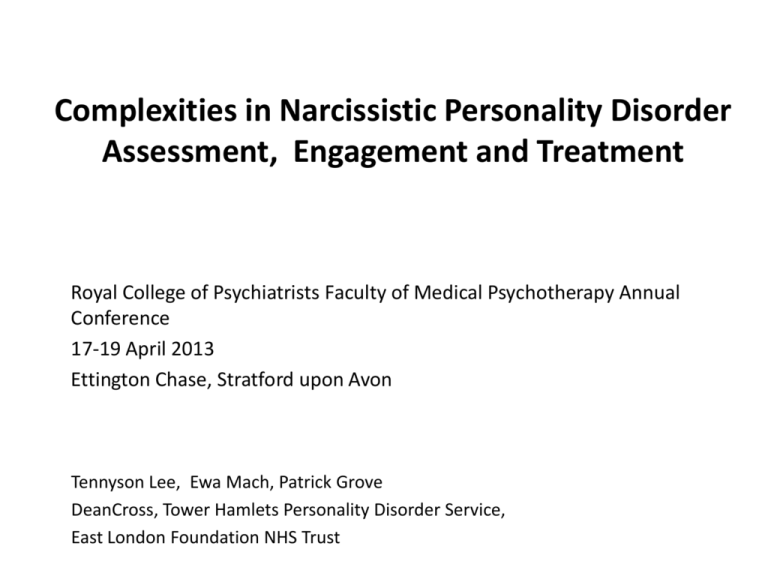
Complexities in Narcissistic Personality Disorder Assessment, Engagement and Treatment Royal College of Psychiatrists Faculty of Medical Psychotherapy Annual Conference 17-19 April 2013 Ettington Chase, Stratford upon Avon Tennyson Lee, Ewa Mach, Patrick Grove DeanCross, Tower Hamlets Personality Disorder Service, East London Foundation NHS Trust Overview Narcissism Mentalization Based Treatment Clinical material and responses Discussion Different psychoanalytic uses of term Sexual perversion Havelock Ellis: person takes self as sexual object Stage of development Freud Object relationship Rosenfeld, Kohut, Kernberg Self esteem A concentration of psychological interest upon the self Kohut Deficit ie arrest in development of self structure Deficit in mother’s empathy Need for being noticed, approved Need to idealise parent and self Endless search for self object to complete development Kohut: therapy implications Permit reconstruction of original selfstrivings Therapist offers himself as selfobject, allows Mirroring TF Idealising TF Empathy > conflict eg if patient rages at lack of attention Need for preinterpretation phase of work Kernberg conflict ie faulty development Pathological self structure: Fusion of actual and ideal self and ideal object Grandiose self as defence vs rage and envy Unacceptable self images projected into external objects Defensive aim is to Maintain self admiration Depreciate other Avoid dependency Kernberg: therapy implications Interpretation to clarify the rage Link this to yearnings for love of mother Increase capacity to give up on perfection for intimacy and reality cccccccccccc Clarkin JF, Yeomans FE, Kernberg O. Psychotherapy for Borderline Personality focusing on object relations. Ch 6 Assessment Phase II Treatment Contracting pp 179-220. Washington, Am Psychiatric Publishing, 2006. DSM-IV Criteria for NPD need 5 or more of following: 1. 2. 3. 4. 5. 6. 7. 8. 9. Grandiose sense of self importance. Fantasies of success/power. Believes self to be special and unique. Requires excessive admiration. Entitlement. Interpersonally exploitative. Lacks empathy. Envious of others. arrogant, haughty behaviors / attitudes. Only a partial capture viz thick vs thin skinned (Rosenfeld) oblivious vs hypervigilant (Gabbard) Oblivious Hypervigilant • • • • • • • • • No awareness Arrogant and aggressive Self absorbed Has a ‘sender but no receiver’ Apparently impervious to having feelings hurt by others Highly sensitive Inhibited, shy, self effacing Directs attention out Listens out for slights, criticisms • Easily hurt Overview Narcissism Mentalisation-Based Treatment Clinical material and responses Discussion Mentalization How to make sense of yourself and others Recognition of one’s own and other’s mental states Recognition that what is in the mind is in the mind Function of prefrontal cortex, acts as buffer when aroused Fragile Mentalization in BPD patients Failed mentalization: cause and effect Poor attachment Trauma Failure mentalization Teleological stance Psychic equivalence Pretend mode Implications for Mentalization based treatment (MBT) in context of an attached relationship Giving patient the experience of being mentalized Giving patient the opportunity to mentalize Therapeutic stance Steps Mentalizing the transference Therapist stance in MBT overall aim: stimulate mentalizing (> insight) active empathic not knowing non defensive Steps in MBT Support Clarification, challenge, stop and stand Define interpersonal context Identify if in non mentalizing mode: psychic equivalence, pretend mode, teleological stance Affect elaboration Basic mentalizing Stop, rewind, explore Transference tracers Interpretive mentalizing Mentalising the transference Mentalizing the transference Validation of transference Exploration of transference Accept enactment Collaboration at arriving at interpretation Alternative perspective from therapist Monitor patient’s reaction to the interpretation Interpret patient’s reaction to the interpretation Overview Narcissism Mentalisation-Based Treatment Clinical material and responses Passivity lack of attachment antagonism thin and thick skinned Discussion Clinical material Passivity lack of attachment antagonism thin and thick skinned Clinical eg 1 the woman who wants to do it all herself Presentation in the programme High sensitivity / wish to control others’ perception of her Antagonism / withholding or being dismissive in the sessions Sense of entitlement Grandiose fantasies Mentalizing difficulties Pseudomentalizing Extensive knowledge of thoughts and feelings of others not necessarily based on evidence overactive Pretend mode Little affect present or expressed in session Psychic equivalence Inflexible Video session Treatment Therapist stance active, empathic, not knowing, non defensive, aim: to stimulate mentalizing Attention to exquisite sensitivity graded work: 1st half of programme ‘to be understood’ before ‘to understand’, therapist centred interpretations Addressing the psychic retreat contract, life outside DeanCross Supervision: attention to the countertransference Use of the team Using Psychodrama techniques in working with narcissistic patients Clinical eg 2 the man who gets lost in his own thinking ’ What is Psychodrama? What is Doubling? Session Lack of attachment Clinical eg 3 the man who ran too fast Brief Structured MBT Objective Learn mentalizing approach to main current difficulty with relationship focus Approach Psychoeducative Practical Active (CAT, CBT) Therapist Patient Standalone: a short intervention and an assessment Structure ‘6+2’ Fortnightly ie 4 months Clear frame eg re missed sessions Brief Structured MBT Phase Session Objective Business meeting Business meeting Clarify structure 2 Mentalisation file Objectives of Rx 3 Mentalisation file Mentalisation letter Phase 2 4,5,6 Id focus Work on focus End session 7 Ending letter of therapist 8 Ending letter of patient Review of Rx Phase 1 Final meeting What happened? Themes addressed control: shame feedback Therapist goodbye letter Took risks, allowed exploration of relationship Patient goodbye letter Denial of feelings realised I wasn’t quite in the room Went onto programme What may have helped Passivity Clarity of frame Input of patient Antagonism Tuning into the programme Sensivity Working out the soft spots Kohut: Empathy > conflict Allowed mirroring and idealizing TF Need for preinterpretation phase of work Attachment: Relationship with the therapist Did develop Dx of patient BPD and N Passivity treatment contract Obstacles to Transference Focused Psychotherapy with Narcissistic Patients Patient’s defensive grandiosity often leads to: • A retreat from life’s challenges. • Feeling exempt from demands or obligations. • A cavalier attitude toward treatment (why submit?). Importance of addressing secondary gain: • Patient may depend on social services or family. • “Can not” vs “will not” function. Managing suicidality / self-injury Contracting Objectives of treatment contract Sets treatment frame Define responsibility of patient and service Assesses if patient motivated to pursue Rx at DC Where fits into programme After assessment Needs sign off before Rx Guiding principle Allow service to remain neutral and think clearly Limit patient’s 2ndry gains Clarkin JF, Yeomans FE, Kernberg O. Psychotherapy for Borderline Personality focusing on object relations. Ch 6 Assessment Phase II Treatment Contracting pp 179-220. Washington, Am Psychiatric Publishing, 2006. Treatment Contract: Patient responsibilities 12 itemised points wrto treatment hierarchy Safety: DSH or other destructive acts (incl passivity) Crisis plan Frame Contact, attendance, Emotional importance Openness Silence, withholding, lying Treatment Contract: Service responsibilities Safe setting Stable environment Advance notice re any changes to the programme Try help the patient gain cognitive and emotional understanding Clarify the limits of the service’s involvement Contracting: experience • Individual meetings • Group meetings ‘boring’ to ’can see the point’ ‘its obvious’ Use of both contempt and of group norm Small things elicit big things: the brother who brings Antagonism Staff Countertransference Seduced Bored, indifference* Defensive Patients Similar Overview Narcissism Mentalisation-Based Treatment Clinical material and responses Discussion A summary of modications Passivity : contracting Attachment: Brief structured individual treatment Sensitivity and adherence to grandiose self MBT: pseudomentalising Psychodrama: doubling Therapist centred interpretations Graded work: 1st half of programme ‘to be understood’ before ‘to understand’ Antagonism Supervision: attention to the CTF cccccccccccc Clarkin JF, Yeomans FE, Kernberg O. Psychotherapy for Borderline Personality focusing on object relations. Ch 6 Assessment Phase II Treatment Contracting pp 179-220. Washington, Am Psychiatric Publishing, 2006. Postscript: the man who ran too fast Work Destructive behaviour Relationships Postscript: the woman who wants to do it all herself ? A woman in a parallel universe Review using treatment contract


